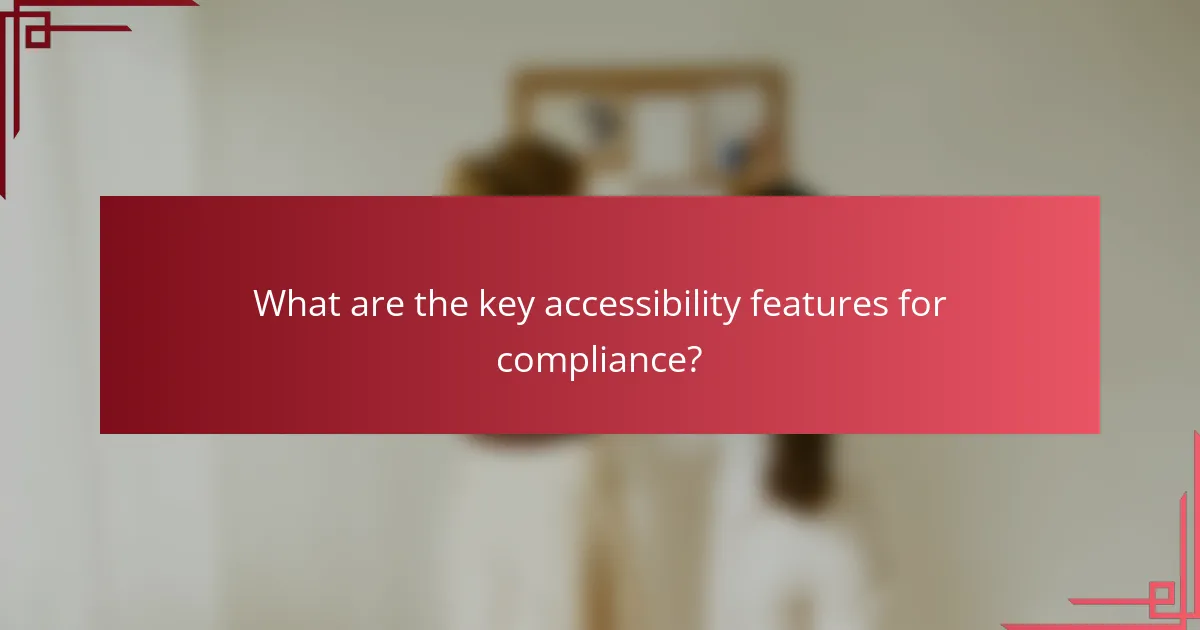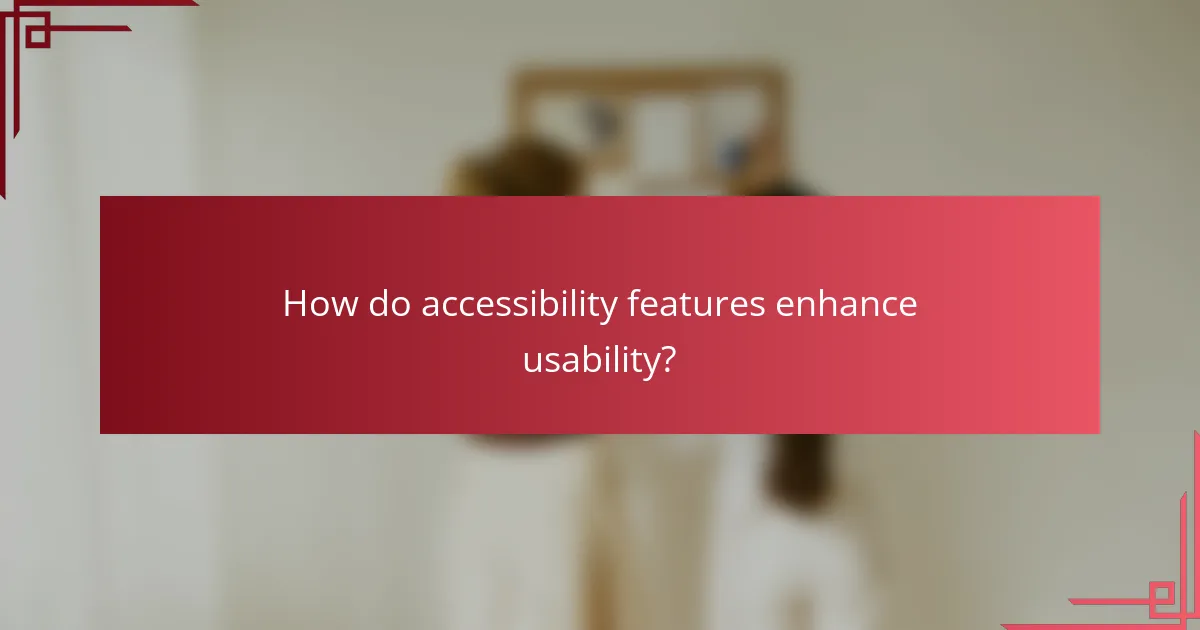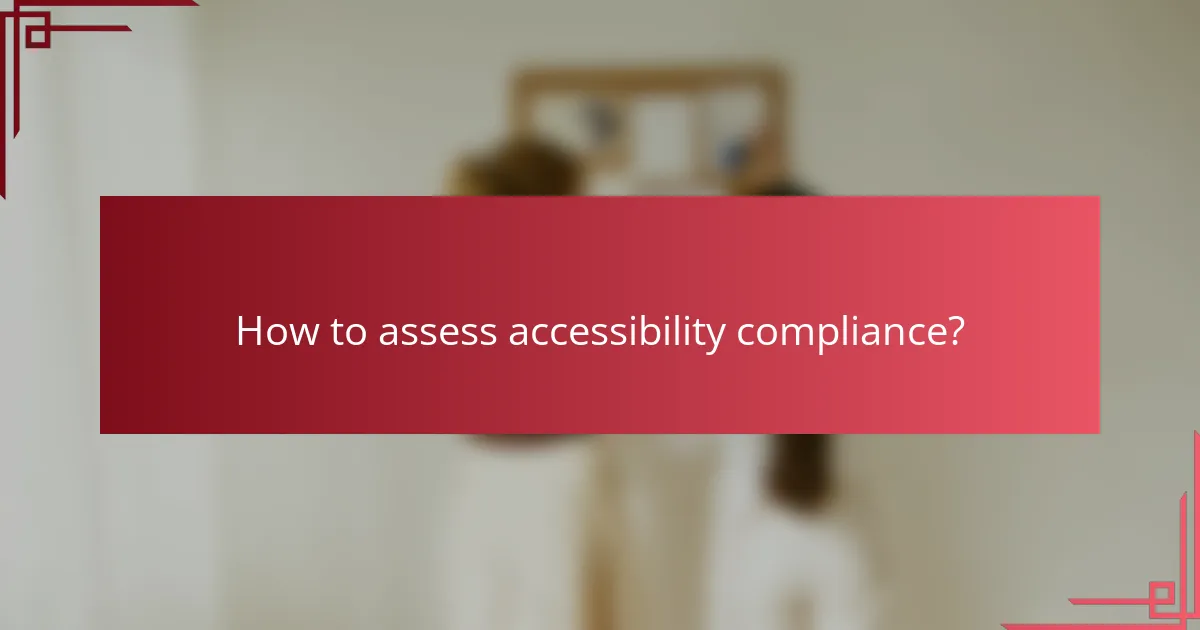Accessibility features play a crucial role in ensuring that digital content is compliant with standards that promote usability for individuals with disabilities. By enhancing navigation and interaction, these features not only improve the experience for users with disabilities but also foster greater customer inclusivity, ultimately benefiting businesses by broadening their audience and increasing satisfaction.

What are the key accessibility features for compliance?
Key accessibility features for compliance ensure that digital content is usable by individuals with disabilities. These features are often guided by established standards and regulations that promote inclusivity and usability across various platforms.
Web Content Accessibility Guidelines (WCAG)
The Web Content Accessibility Guidelines (WCAG) provide a comprehensive framework for making web content more accessible to people with disabilities. These guidelines are organized around four principles: perceivable, operable, understandable, and robust, often referred to as POUR.
To comply with WCAG, websites should implement features such as text alternatives for non-text content, keyboard navigability, and sufficient contrast between text and background colors. Regular audits against these guidelines can help identify areas for improvement.
Section 508 Compliance
Section 508 requires federal agencies in the United States to ensure that their electronic and information technology is accessible to people with disabilities. This includes websites, software, and hardware used by the public or employees.
To achieve Section 508 compliance, organizations should conduct accessibility testing and provide training for staff on best practices. Tools like screen readers and accessibility checkers can assist in identifying compliance issues.
Americans with Disabilities Act (ADA) Standards
The Americans with Disabilities Act (ADA) sets forth standards that prohibit discrimination against individuals with disabilities in various areas, including digital accessibility. While the ADA does not explicitly mention web accessibility, courts have interpreted it to apply to websites and online services.
To align with ADA standards, businesses should ensure their websites are accessible to all users, including those with visual, auditory, or cognitive impairments. This can involve implementing features such as alt text for images, captions for videos, and clear navigation structures.

How do accessibility features enhance usability?
Accessibility features significantly enhance usability by making digital content easier to navigate and interact with for all users, including those with disabilities. These features ensure that everyone can access information and services, improving overall customer inclusivity and satisfaction.
Improved Navigation for All Users
Accessibility features streamline navigation by providing clear pathways for users to find information. For instance, using consistent layouts, descriptive headings, and keyboard shortcuts can help users move through content efficiently. This is particularly beneficial for individuals with visual impairments or those who rely on keyboard navigation.
Implementing features like skip links allows users to bypass repetitive content, enhancing their experience. Websites should aim for intuitive navigation that minimizes the number of clicks needed to reach desired information.
Assistive Technology Compatibility
Many accessibility features are designed to work seamlessly with assistive technologies, such as screen readers and voice recognition software. Ensuring compatibility means that users can interact with digital content in ways that suit their needs, whether through auditory feedback or voice commands.
To enhance compatibility, developers should follow established guidelines like the Web Content Accessibility Guidelines (WCAG). Regular testing with various assistive technologies can help identify and resolve compatibility issues, ensuring a smoother user experience.
Enhanced User Experience
Accessibility features contribute to an enhanced user experience by creating a more inclusive environment. Features such as adjustable text sizes, high-contrast color schemes, and alternative text for images allow users to customize their interactions based on personal preferences and needs.
Additionally, providing clear instructions and feedback during interactions can prevent confusion and frustration. Regularly soliciting user feedback can help identify areas for improvement, ensuring that the digital experience remains user-friendly for everyone.

What are the benefits of customer inclusivity?
Customer inclusivity offers significant advantages, including access to a wider audience and enhanced customer satisfaction. By ensuring that products and services are accessible to all, businesses can foster a more diverse customer base and improve overall engagement.
Broader Market Reach
Embracing customer inclusivity allows businesses to tap into a larger market. By catering to individuals with disabilities or specific needs, companies can attract customers who might otherwise feel excluded. This can lead to increased sales and a more diverse clientele.
For example, implementing features such as screen readers or alternative text for images can make websites accessible to visually impaired users. This not only broadens the market reach but also aligns with accessibility standards like the Web Content Accessibility Guidelines (WCAG).
Increased Customer Loyalty
When customers feel valued and included, they are more likely to remain loyal to a brand. Inclusivity fosters a sense of belonging, which can translate into repeat business and positive word-of-mouth referrals. Companies that prioritize accessibility often see higher retention rates.
Offering personalized experiences, such as customizable interfaces or tailored communication, can further enhance loyalty. For instance, brands that provide options for different languages or communication styles are more likely to build lasting relationships with diverse customer segments.
Positive Brand Reputation
A commitment to customer inclusivity can significantly enhance a brand’s reputation. Companies recognized for their inclusive practices often enjoy a favorable public image, which can attract new customers and retain existing ones. This reputation can be a key differentiator in competitive markets.
Engaging in community outreach and supporting initiatives that promote inclusivity can also bolster a brand’s standing. For example, partnering with organizations that advocate for people with disabilities not only demonstrates commitment but also helps build trust within the community.

How to assess accessibility compliance?
Assessing accessibility compliance involves evaluating how well a digital product meets established accessibility standards, such as the Web Content Accessibility Guidelines (WCAG). This assessment ensures that users with disabilities can effectively interact with the product, promoting inclusivity and usability.
Accessibility Audits
Accessibility audits systematically evaluate a website or application against accessibility standards. These audits can be conducted manually or through automated tools, focusing on elements like color contrast, keyboard navigation, and screen reader compatibility. Engaging a certified accessibility expert can enhance the audit’s effectiveness and provide actionable recommendations.
To conduct an audit, start by reviewing key pages and functionalities. Aim to cover a representative sample of the site, ideally including high-traffic areas. Document findings clearly, noting both compliance and areas needing improvement.
User Testing with Diverse Groups
User testing with diverse groups involves gathering feedback from individuals with various disabilities to assess real-world usability. This method provides insights into how accessible a product truly is, beyond what automated tools can reveal. It’s essential to include users with different disabilities, such as visual, auditory, and motor impairments.
When organizing user testing, recruit participants through disability organizations or community groups. Prepare specific tasks for users to complete, and observe their interactions. Gather qualitative feedback to understand their experiences and identify barriers that may not be apparent through standard testing methods.
Automated Accessibility Testing Tools
Automated accessibility testing tools help identify potential compliance issues quickly and efficiently. These tools scan web pages for common accessibility errors, such as missing alt text for images or improper heading structures. While they can save time, they should not replace comprehensive audits or user testing.
Popular tools include Axe, WAVE, and Lighthouse, which can be integrated into development workflows. Use these tools regularly during the development process to catch issues early, but remember to validate findings with manual checks and user feedback for a thorough assessment.

What are the best practices for implementing accessibility features?
Implementing accessibility features effectively requires a proactive approach that integrates these elements throughout the design and development process. Best practices include early incorporation, ongoing training, and regular updates to ensure compliance and usability for all users.
Incorporating Accessibility from the Start
Integrating accessibility features from the beginning of a project is crucial for creating an inclusive user experience. This involves adhering to established guidelines such as the Web Content Accessibility Guidelines (WCAG) and considering diverse user needs during the design phase.
For example, using semantic HTML elements helps screen readers interpret content correctly, while designing with color contrast in mind ensures readability for users with visual impairments. Conducting user testing with individuals who have disabilities can provide valuable insights into potential barriers.
Continuous Training for Development Teams
Ongoing training for development teams is essential to maintain awareness of accessibility standards and best practices. Regular workshops and resources can help keep team members informed about the latest tools and techniques for creating accessible products.
Encouraging developers to participate in accessibility-focused communities or conferences can foster a culture of inclusivity. Providing checklists or guidelines can also help teams consistently apply accessibility principles throughout the development lifecycle.
Regular Updates and Maintenance
Accessibility is not a one-time effort; it requires regular updates and maintenance to adapt to evolving standards and user needs. Periodic audits of existing products can identify areas for improvement and ensure compliance with current regulations.
Establishing a routine for testing and updating accessibility features can prevent issues from arising over time. This may include using automated tools for initial assessments and conducting manual reviews to address more complex accessibility challenges.

What are the emerging trends in accessibility?
Emerging trends in accessibility focus on integrating advanced technologies and addressing diverse user needs. These trends aim to enhance usability and ensure inclusivity for all individuals, particularly those with disabilities.
AI and Accessibility Enhancements
Artificial Intelligence (AI) is revolutionizing accessibility by providing tools that adapt to individual user needs. For example, AI-driven applications can analyze user behavior and preferences to offer personalized content, making digital environments more navigable.
Consider implementing AI features like automated captioning or image recognition, which can significantly improve user experience for those with hearing or visual impairments. However, ensure that these technologies comply with established accessibility standards to avoid unintentional barriers.
Voice User Interface (VUI) Adoption
Voice User Interfaces (VUIs) are becoming increasingly popular as they allow users to interact with devices through speech. This trend is particularly beneficial for individuals with mobility challenges or those who prefer hands-free operation.
When designing VUI systems, focus on natural language processing to understand diverse accents and speech patterns. Testing with real users can help identify areas for improvement, ensuring that the interface is intuitive and accessible to a broad audience.
Increased Focus on Mental Health Accessibility
Accessibility is expanding to include mental health considerations, recognizing that digital environments can impact users’ psychological well-being. This trend emphasizes creating supportive online spaces that cater to individuals with mental health conditions.
To enhance mental health accessibility, consider features like calming design elements, easy navigation, and clear communication. Providing resources and support options can also foster a more inclusive atmosphere, making it easier for users to seek help when needed.
